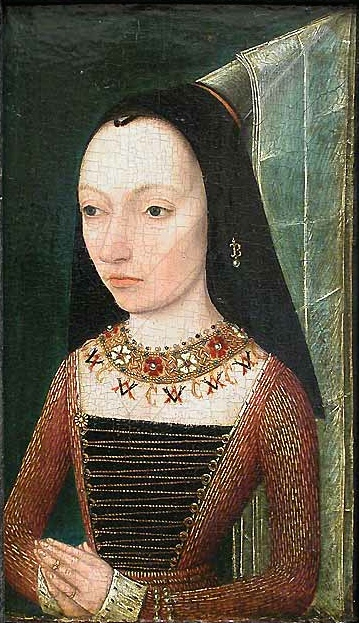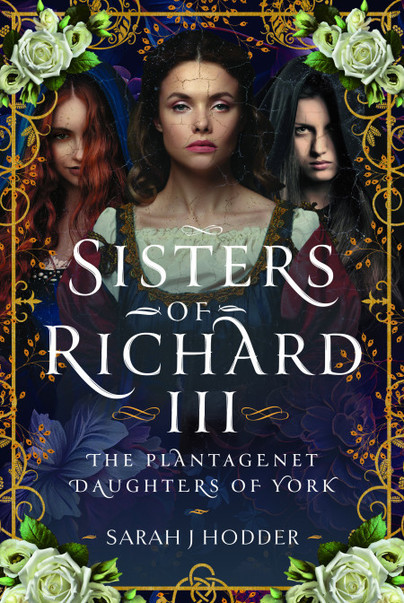Women’s History Month – Sarah J Hodder
Sisters are doing it for themselves
The Daughters of York: Anne, Duchess of Exeter; Elizabeth, Duchess of Suffolk; Margaret, Duchess of Burgundy
In the meantime, the duke of Clarence before-named, brother to king Edward, had been fully reconciled to the king by the mediation of his sisters, the duchesses of Burgundy and Exeter, of who, the one without the kingdom, and the other within it, entreated the duke to make peace with his brother.
Croyland Chronicle.
When I write about the subjects in my books, I like, first and foremost, to find the human essence of their character. That we can never really know a person is something I believe to be true. With the exceptions of close family members or friends (and sometimes not even then), it would be foolish to say we really know any of our contemporaries, let alone an individual who lived over half a century ago. But that doesn’t mean that we can’t see glimpses of a person, and certainly when looking into the lives of those who came before us, we can meet them as we see them and get to know them a little through the actions they took and the footprint they left behind.
There is also an inherent danger of applying twenty-first century thoughts and beliefs to a fifteenth and sixteenth-century individual, an easy hole to fall down, particularly when trying to tell a story in an empathetic way. Although I hope I avoid bringing my modern viewpoint to bear, I still try to view the women I write about through the eyes of being human. After all, we may live, today, in a totally different world to our medieval counterparts, but with a shared membership of the human world we’ve all breathed, we’ve all loved and we’ve laughed, we’ve cried and danced, feasted and scrimped, been scared, been happy, been sad… in essence we’ve all lived.
So, when I began my research into the sisters of York, otherwise known as Anne, Elizabeth and Margaret Plantagenet, my starting point was to discover the life they led, and tell their human story. My particular curiosities in them as subjects was what was it like to have two of your brothers become king; for your father to die in battle when you’re still in your teenage years (Anne would have just been in her early 20s); how would you deal with life if one of your brother’s had another of your brother’s executed for treason? And what could they possibly have known about one of the great mysteries today, the disappearance of the Princes in the Tower. Although we can never know how they felt about these events, we can find out what they did about them. So, in my latest book, The Sisters of Richard III, I hope to bring the story of three strong, courageous women to you in a way that we can feel that we know them just that little bit more. That they were not just the sisters of two kings, but that they have a story in their own right. And if you know nothing about the York sisters at all, here’s a little bit about why, to me, they are so interesting:
The York sisters, the daughters of Richard, Duke of York and Cecily Neville, always knew that they and their family were important in the scheme of things. Their mother, Cecily Neville, or ‘proud Cis’ as she was sometimes known, ensured that as well as learning their academic subjects, the York children were raised to know their place in the world. Pride of birth and lineage, particularly in children of noble descent was encouraged. This was something their mother knew all too well, with Cecily being described as ‘queen-like in all her actions, noble and dignified in her conduct and demeanour’. So, the family was, without doubt, a noble family, but they were never really intended for the throne.
Although England had been under Plantagenet rule since the mid-twelfth century, a branch of the Plantagenets — The House of Lancaster — had ruled England since 1399, when Henry IV, eldest son of the Duke of Lancaster and grandson of Edward III, had led a rebellion against his cousin, the increasingly unpopular Richard II. The rule of England had subsequently passed to his son, Henry V and then to his son, Henry VI, who succeeded to the throne as a mere babe in 1422. When, in 1453, Henry VI and his queen, Margaret of Anjou, gave birth to a baby boy, it should have been a joyous occasion to celebrate that an heir was born, and that the future of the House of Lancaster was ensured for decades to come.
Those with any knowledge of the Wars of the Roses will know that was not, of course, the case. At the time of his son’s birth, Henry VI was suffering poor health. Unable to formerly recognise his son, and in a catatonic state, he would eventually recover his health somewhat, but his sickness began a chain of events that led to the Wars of the Roses and the House of York taking on the House of Lancaster for the ultimate prize, the throne of England.

Anne, Elizabeth and Margaret Plantagenet were born around a decade before the Wars of the Roses began; Anne, the eldest daughter and eldest child of the York family in 1439, Elizabeth in 1444 and Margaret in 1446. The year Margaret entered the world, her eldest sister, Anne, was married to Henry Holland, Duke of Exeter, a Lancastrian loyalist, a union that in the years to come both she and her family lived to regret. Although aged just 7, she may have left the family home to live with her father-in-law and new husband, just as Margaret made her appearance into the world.
Elizabeth would follow her sister into marriage in 1458, marrying John de la Pole, the Duke of Suffolk and earning herself the title of Duchess of Suffolk. With their elder brothers, Edward and Edmund, spending much of their time in their own household in Ludlow, Margaret would become quite the trio with her younger brothers, Richard and George, later better known to history as George, Duke of Clarence and Richard, Duke of Gloucester (and, of course, eventually Richard III). Later in their lives, Margaret and George in particular were said to have a close relationship, as testified by the writer of the Croyland Chronicle:
This piece of foreign history I have here inserted, because it was universally mentioned that after the death of Charles, his widow, the duchess, lady Margaret, whose affections were fixed on her brother Clarence beyond any of the rest of her kindred…
That these three were particularly close as children may further be illustrated when Margaret found herself in strife in her adopted homeland of Burgundy, it was Richard who stepped up to assist, where her eldest brother, Edward, had failed to do so.
The girls’ father, Richard Duke of York, was himself a descendant of Edward III, making him a cousin to Henry VI, but the descent of the House of York was through a more junior line (Edmund, Duke of York being Edward III’s 4th eldest son, John of Gaunt, the Duke of Lancaster was his third). But in the mid-1450s, when factions began forming around the throne and the civil wars began, Richard found himself the main contender for the crown, as it became apparent that Henry VI was not strong enough to pacify his warring nobles, lead his country and ultimately keep the House of Lancaster on the throne of England.
As Anne, Elizabeth and Margaret grew up from young girls into womanhood, they did so against a backdrop of battles, political infighting and uncertainty. But the challenges their family faced also instilled in them the value of family loyalty, as their father, backed by their powerful Neville relatives, fought both for his freedom, his family, his life and the crown of England. This lesson in loyalty was something the York girls seemed to learn much better than their brothers ever did.
As their brothers grew from boys to men, they also found themselves amongst the chaos of war and when their father and brother, Edmund, were killed in December 1460, it would be their brother, Edward, who would fight to avenge his father and take the ultimate prize, being crowned King Edward IV in April 1461.
The York family had reached the pinnacle of power and they had done so by working as a strong family unit, alongside their closest allies, and although they couldn’t take to the battlefield, the females of the family would have played their role just as much as the men. Now the most important family in the land, the future should have been golden. And it was for a while. But eventually the family loyalty that served them so well was forgotten, as brother turned upon brother, cousin upon cousin. Edward faced rebellion from his cousin, Richard Neville, the man who fought so valiantly to place him on the throne and known to history as ‘Warwick, the kingmaker’. Astonishingly his brother, George, would side with Warwick against his own family. After Warwick’s death, George and Richard would fight over the Warwick inheritance, and George and Edward would once again take each other on, until it could only end with the loss of life. Edward had his brother, George, put to death; an event that shook the family to the core and Margaret, especially, had to deal with the loss of her favourite brother. After Edward’s death, Richard of York would usurp his nephews, with rumours abound still today that he had them murdered, and took the throne for himself as Richard III.
Whilst the men in their family battled each other, Anne, Margaret and Elizabeth remained loyal to their York name, desperately trying to hold their family together, whilst dealing with their own troubles that life threw their way.
Anne’s early marriage to a Lancastrian, a marriage which found her stuck between loyalty to a husband she may have loved (we have no evidence either way) and her family was eventually dissolved, and she managed to find short-lived happiness before her own untimely death. Elizabeth, the great dissembler of the family, and a mother of many sons who were proud to carry the badge of the White Rose, would eventually find herself having to survive the reign of the Tudor King, Henry VII, whilst her sons continued to battle for the House of York. And Margaret, Duchess of Burgundy, always the proud Yorkist warrior from afar, never forgot her loyalty to her family and the House of York and continued to champion their cause until her death.
When the tumultuous but fascinating story of the York family rule ended in 1483, with the death of the last male member — their brother Richard, King Richard III — it was the York women who were the ultimate survivors. Elizabeth, Margaret and their mother, Cecily (who lived to the grand old age of 80, dying in 1495) continued as representatives of the House of York well into the Tudor era and continued to carry their Yorkist name with pride. And although Anne of York’s life was cut short, she remained very much a part of the York family story when her DNA helped identify the skeleton of her brother, Richard, as the king in the car park in 2012.

Order your copy of Sisters of Richard III here.

